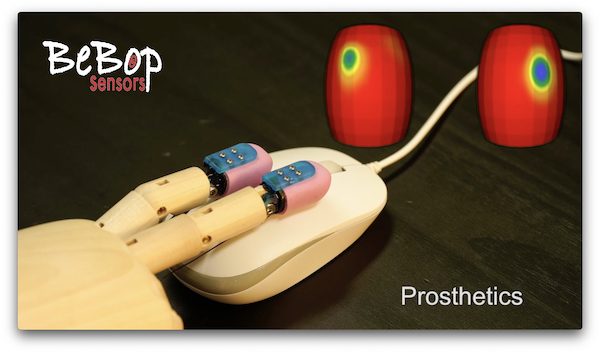A Nervous System for Robots
BeBop’s fabric-based sensor skin-like covers deliver tactile awareness for humanoid robots and prosthetics.

Fabric-based sensor skin creates a nervous system for robots. Image Courtesy of BeBop Sensors
Latest News
May 31, 2022
The robots are coming, but the real question is, are the robots adequately prepared to effectively take on human work?
The answer is yes, but in many cases, not entirely just yet. BeBop Sensors, a leader in smart fabric sensing technologies, hopes to change that dynamic with the RoboSkin line of skin-like coverings that promise to bring tactile awareness to humanoid robots and medical prosthetics, promoting smoother operation and ensuring robots experience the world more similarly to their human counterparts.
While robots have come a long way thanks to advances in vision and learning, there are still sensory gaps, primarily in the area of touch. Without such capabilities, humanoid robots struggle to perform human tasks. “So many interactions involve touch—where cameras cannot see what is happening,” says Keith McMillen, founder and CTO at BeBop Sensors. “A robotic hand with our RoboSkin understands the shapes and motion of an object it might be grasping. This is essential for augmenting our workforce in manufacturing and agriculture.”
Humanoid robots with dexterous sensing deliver the spatial resolution and sensitivity required for a true partnership between humans and robot helpers. BeBop Sensors’ Smart fabric treats the outside fibers with conductive nano-particles, which changes electrical properties when a force (from 5 grams to 50 Kg for the RoboSkin) interacts with the fibers. Spatial resolution and sensitivity that meets or exceeds human abilities is possible while RoboSkin’s responsive surfaces make manipulation of items natural. “We can resolve less than 2mm features making it as good or better than human sensing,” McMillen says.
With those capabilities, robots outfitted with BeBop RoboSkin can fit through standard human doors and use common tools without requiring a special environment to be built to contain their operations, BeBop officials say.
Somes examples of BeBop RoboSkin in action:
- A carebot can better assist with lifting and/or daily tasks, leveraging RoboSkin to sense safety issues and move about the floor, avoiding objects that shouldn’t be stepped on.
- Sensor soles provide data for zero moment point walking, always falling forward to closely mimick human steps.
- Telerobotic digits outfitted with RoboSkin send rich data back to the haptics of a controller to complete the loop and execute an action, enabling bionic limbs to achieve a human-level sense of touch.
To learn more about BeBop’s RoboSkin, check out this video.
Subscribe to our FREE magazine, FREE email newsletters or both!
Latest News
About the Author
Beth Stackpole is a contributing editor to Digital Engineering. Send e-mail about this article to [email protected].
Follow DE





